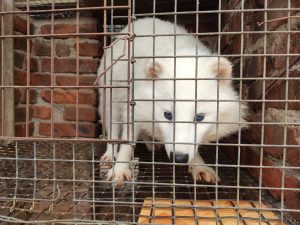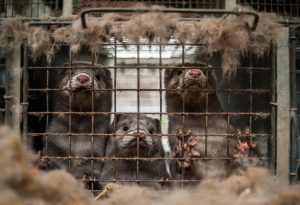-
Adopt
-
Veterinary Care
Services
Client Information
- What to Expect – Angell Boston
- Client Rights and Responsibilities
- Payments / Financial Assistance
- Pharmacy
- Client Policies
- Our Doctors
- Grief Support / Counseling
- Directions and Parking
- Helpful “How-to” Pet Care
Online Payments
Referrals
- Referral Forms/Contact
- Direct Connect
- Referring Veterinarian Portal
- Clinical Articles
- Partners in Care Newsletter
CE, Internships & Alumni Info
CE Seminar Schedule
Emergency: Boston
Emergency: Waltham
Poison Control Hotline
-
Programs & Resources
- Careers
-
Donate Now
What is the fur trade?
The fur trade is valued at around $40 billion and encompasses fur factory farms, the trapping of wild animals for their fur, and the sale of these fur products. Fur factory farms, which supply about 85% of the fur trade, confine hundreds of millions of wild, fur-bearing animals in small, barren, wire cages for their entire lives. The size of a fox’s fur farm cage, for example, is roughly 3 feet by 2 feet. Other animals that suffer on fur farms include rabbits, raccoon dogs, and mink. Roughly 100 million of these animals are killed every year for their fur, to be used in coats, shoes, and accessories; about half are killed for fur trim alone.
Confining these naturally active and curious animals in such conditions has severe physical and mental health effects. Deprived of the ability to engage in natural behaviors such as digging, roaming large territories and, for semi-aquatic mink, swimming and diving, fur-farmed animals are known to display stereotypical behaviors, an indicator of mental distress, wherein they repeatedly pace and circle their cages. Fur farm conditions can also lead animals to self-mutilate and housing in unnatural social groupings can lead to fighting between cage mates, and even cannibalism.
While fur farms supply about 85% of the fur trade, trapping makes up the remaining 15%, meaning that roughly 15 million furbearing animals, such as coyotes and beaver, are trapped each year in leghold traps, snares, and drowning traps. These animals are commonly trapped for days, without food, water or shelter, or any way to protect themselves from predators. In struggling to free themselves, animals may break bones or teeth, or even try to chew off their own limb. When trappers finally arrive to check their traps, some may stomp or beat the animals to death, rather than a more merciful bullet to the head. Traps are also problematic because they are indiscriminate. Many trapping incidents involve non-target animals, including endangered species or even companion animals. The problem of non-target animals being caught is widespread; see these examples of indiscriminate trapping accidents in Massachusetts. (Content warning: graphic images.)
Some fur farms claim to be “high welfare,” but investigations have proven otherwise. Some farms in Finland, supposedly with high welfare standards, for example, raise oversized “monster foxes” (bred to be unnaturally big so that they have more fur, at the expense of the animal’s welfare). Investigations at a fox and raccoon dog fur farm and at a rabbit fur farm in East Asia, both December 2015, revealed horrendous conditions, including foxes being skinned alive.
 How are animals killed on fur farms?
How are animals killed on fur farms?
The method by which animals on fur farms are killed is cruel as well. Their pelts are typically in their prime before the animals have reached one year old, and so they are typically killed before their first birthday. They may be gassed, electrocuted, beaten, or their necks may be broken. A 2015 undercover investigation on a fur farm in China by Humane Society International documented foxes being beaten to death and rabbits being hit on the head, shackled by their back legs, and their throats cut. Other investigations have shown raccoon dogs on fur farms being slammed against the ground and then being skinned alive.
How many animals are impacted?
Around one hundred million animals are killed for fur each year; 100 animals may be killed for a single fur coat alone. Roughly 85 percent of animals killed in the fur trade are raised on fur factory farms and the remaining 15 percent are trapped in the wild. The USA, Canada, and Russia are the largest providers of wild-trapped animals; more than 3 million animals were trapped for their pelts in North America in 2017. In terms of fur farming, in 2018:
- Canada – farmed 1.8 million animals (1.76 million mink and 2,360 foxes)
- United States – farmed 3.1 million mink
- European Union – farmed 37.8 million animals (34.7 million mink, 2.7 million foxes, 166,000 raccoon dogs, and 227,000 chinchilla
- China – farmed 50.5 million animals (20.7 million mink, 17.3 million foxes, and 12.3 million raccoon dogs
How does fur farming connect to pandemics?
As with the conditions in which animals are raised for food on factory farms, fur farming creates conditions ripe for the emergence of new zoonotic diseases. Highly stressed animals are kept in extremely close quarters, providing ample opportunities for new viruses to evolve in animals with weakened immune systems, and to then jump to people in a form that can infect and sicken humans. Further, once a pathogen has spilled over from nonhuman animals to humans, it can then subsequently be passed back to animals, a process called spillback. Spillback is particularly dangerous, as it gives the pathogen even more time to evolve into a more dangerous and/or more transmissible disease.
The coronavirus has in fact been documented on numerous mink farms in several countries, including 11 mink farms in the United States, 166 mink farms in Denmark, 68 in the Netherlands, one in Spain, one in Sweden, and an unknown number in Italy.
In response to concerns that a mutation in mink of the novel coronavirus could possibly interfere with the effectiveness of a vaccine for humans, Denmark took drastic action and ordered all farmed mink killed, roughly 15 million animals. As Dr. Gail Hansen of the Humane Society Veterinary Medical Association states, “we have the very real possibility that farmed mink could be a persistent source for the virus and continued infection in people, posing a significant public health threat.”
What can I do to help stop this cruelty?
The fur industry is being tackled on several fronts, including through legislation and regulation, the private sector, and consumer and citizen grassroots pressure. Getting involved in some or all of these areas can help to bring an end to the cruel fur trade.
Support companies with fur-free policies
In the private sector, more than 300 brands and retailers, including Armani, Bloomingdale’s, Burberry, Chanel, Coach, Gucci, H&M, Macy’s, Michael Kors, The North Face, Prada, and Versace, have adopted fur-free policies. By supporting these companies and taking a pledge to go fur-free consumers can help to bring an end to the fur trade.
View a full list of fur-free retailers, follow the tips in this humane shopping guide, and learn more about other animal fashion trades.
Educate your friends, family, and community about the fur trade’s environmental impact
Beyond educating your social circles about the cruelties of the fur trade and the many available alternatives, you can also share information about the environmental damage wrought by fur farming. A dangerous source of pollution, excrement from factory farmed animals pollutes waterways and soil, and harmful chemicals used in tanning and dying processes are released into the environment as well. In contrast, many synthetic animal materials offer a more sustainable choice. For example, synthetic down is lighter, warmer, and biodegradable, and faux-fur is now produced sustainably from a corn industry by-product.
Did you know you can also donate owned fur to help comfort injured or orphaned wildlife?
Check with a local wildlife rehabilitator to see if they are in need of furs, see this list of nationwide rehabilitators that use furs, and also check out Buffalo Exchange, a store with locations in Somerville and Brookline, which accepts fur through its Coats for Cubs program.
Contact your public officials
Many countries, states/provinces, and municipalities have passed bans or limitations on fur farming or the retail sale of fur. Look for opportunities to contact public officials in support of fur ban campaigns.
To date, these governments have taken the following actions:
- Fur farming ban in Austria, Bosnia & Herzegovina, Belgium, Croatia, Czech Republic, Estonia, France (mink), Ireland, Luxembourg, the Netherlands, Northern Ireland, Norway, Republic of Macedonia, Serbia, Slovakia, Slovenia, and the United Kingdom.
- Proposed legislation to prohibit fur farming is under consideration in Bulgaria, Lithuania, Montenegro, Poland, and Ukraine.
- Fur farming is being phased out in Denmark and Japan.
- In Germany (effective 2022), Sweden, and Switzerland the welfare requirements on fur farms have been made so high as to effectively make fur farming economically unviable.
- In New Zealand, the import of mink is prohibited, which effectively bans mink farming.
- India and São Paulo in Brazil have banned fur sales.
- Israel banned the sale of fur, making it the first country in the world to do so.
- In the United States:
- In 2010, Congress passed the Truth in Fur Labeling Act, which requires all animal fur to be labeled, and yet some retailers have continued to sell animal fur products as faux. As animal protection organizations engage the courts in order to fight this deception, consumers can do their part by using this guide to ensure that faux fur they buy is indeed faux.
- In September 2019, California became the first state in the nation to ban fur trapping. And a month later, the state passed legislation banning the sale and manufacture of new fur clothing and accessories. Prior to these statewide mandates, four major California cities passed bans on the sale and manufacturing of fur: Los Angeles, Berkeley, San Francisco, and West Hollywood, which helped to tip the state toward being fur-free.
- New York state has passed a ban on electrocuting fur-farmed animals, and New York City is considering a ban on the sale of fur.
- In October 2020, Wellesley, Massachusetts became the first municipality in the United States outside of California to pass a ban on new fur sales. Weston, Brookline, Plymouth, and Cambridge have also banned new fur sales in Massachusetts.
- In January 2021, An Act prohibiting the sale of fur products was filed in the Massachusetts legislature. Read more about this legislation.
By advocating for and choosing fur-free products, consumers protect animals, public health, and the environment.
Learn more:
- Fur, Humane Society International
- Wildlife Trapping in Massachusetts, MSPCA
- Environment and Health, Fur Free Alliance
- Investigations (undercover videos – warning: graphic footage), The Humane Society of the United States, Humane Society International
- Animals That Infect Humans Are Scary. It’s Worse When We Infect Them Back. The New York Times (January 19, 2022)




